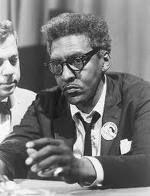 The brilliant, visionary civil rights activist, Bayard Rustin, was born in West Chester, Pennsylvania in 1912 and died in 1987. It is very difficult to sum up his long and varied career, but the main source of his amazingly energetic commitment was his deep and detailed understanding of the oppression of “the Negro” and poor people, especially workers of any color, his consummate ability to build a strategy of protest, and until his last few years, his steadfast devotion to non-violence.
The brilliant, visionary civil rights activist, Bayard Rustin, was born in West Chester, Pennsylvania in 1912 and died in 1987. It is very difficult to sum up his long and varied career, but the main source of his amazingly energetic commitment was his deep and detailed understanding of the oppression of “the Negro” and poor people, especially workers of any color, his consummate ability to build a strategy of protest, and until his last few years, his steadfast devotion to non-violence.
“I am fortified by truth, justice, and Christ…There is no need to fear,” he said.
Four events will focus on Bayard Rustin this fall.
On Sunday, September 26, at 12:30 p.m., Delia Pitts will discuss Rustin’s life at the Princeton Friends Meeting, 470 Quaker Road.
On Wednesday, October 27, the Princeton Public Library will show the film “Brother Outsider,” 7:30 p.m. It is co-sponsored by Princeton Friends Meeting and Not in Our Town.
On Monday, November 1, Not in Our Town and the Princeton Public Library co-sponsor a “Continuing Conversations about Race” discussion that will focus on a Bayard Rustin essay, 7:30 p.m. Ann Yasuhara and Delia Pitts of the Princeton Friends Meeting will moderate.
On Wednesday, November 3, Melissa Harris-Lacewell, associate professor of politics and African American studies, will give a talk at the library, 7:30 p.m., also co-sponsored by Princeton Friends Meeting and Not in Our Town.
Here is more about Rustin, taken from the publicity materials of the library events.
Rustin was raised by his grandparents under the special influence of the Quaker teachings of his activistgrandmother. He is best known for his work in the civil rights movement, especially with Dr. King and designing the great march on Washington of August, 1963. However, that came after many years as an activist including getting beaten up and arrested (the first of many times in his life) in 1942 for refusing to
move to the back of a bus in the south. He spent 3 years in jail (1943-7) for being a conscientious objector to war and refusing to do alternative service. He worked on & off for the Fellowship of Reconciliation (starting 1941) under A.J. Muste, a follower of Gandhi’s teachings on non-violent direct action, which FOR had been using since the 1930’s.
He worked for and with the American Friends Service Committee; generally he was involved with many civil rights groups of the period, helping to found some of them. During various periods of his life he worked for A. Philip Randolph. Randolph had dreamed of a march on Washington for years and together they designed such a march and in 1941 told Pres. Roosevelt if he didn’t desegregate the armed forces and promulgate antidiscrimination laws so that blacks could work in the armaments factories the march would take place. Roosevelt answered with an Executive Order outlawing employment discrimination, but did nothing about the army. Though Rustin disagreed, Randolph called off the march.
They later used similar tactics against Pres. Truman in 1948 to get the armed forces integrated; again due to partial success Randolph called off the march. Rustin went to Montgomery in February 1956 to join King and others in the bus boycott. He found that although King professed non-violence, he had heavily armed guards; Rustin convinced him that there could be no guns in truly non-violent work. He was fully involved in the civil rights movement until after the passage of the Civil Rights Act in 1964. He continued his work of protest, adding to it gay rights and liberation for African countries, until his death.
One may ask why such a brilliant and active person is relatively unknown? One answer is simple: he was a gay man who had spent time in jail for homosexual acts, and he had briefly been a member of the Communist Party. Some just didn’t like working with a gay man, but more important he and others feared that if these facts were generally known it would weaken their ability to struggle for their cause. In fact, this was used several times by blacks and whites as blackmail to keep him out of the picture or to stop an action he was part of planning. There is an additional answer – much less simple: In the mid-1960’s as the left in general and civil rights movement in particular was splitting in various directions, Rustin chose to leave protest for politics by working for reforms under the Democratic Party and ignoring the anti-war activists and most of his previous civil rights collaborators like King. Given the strength and clarity of his analysis of what kinds of change in social structures would be needed to arrive at a just society, his move seemed like to treachery to some, was at least deeply disappointing to others who had worked with him for years and relied on his leadership, and confusing to some of us who are admiring observers.